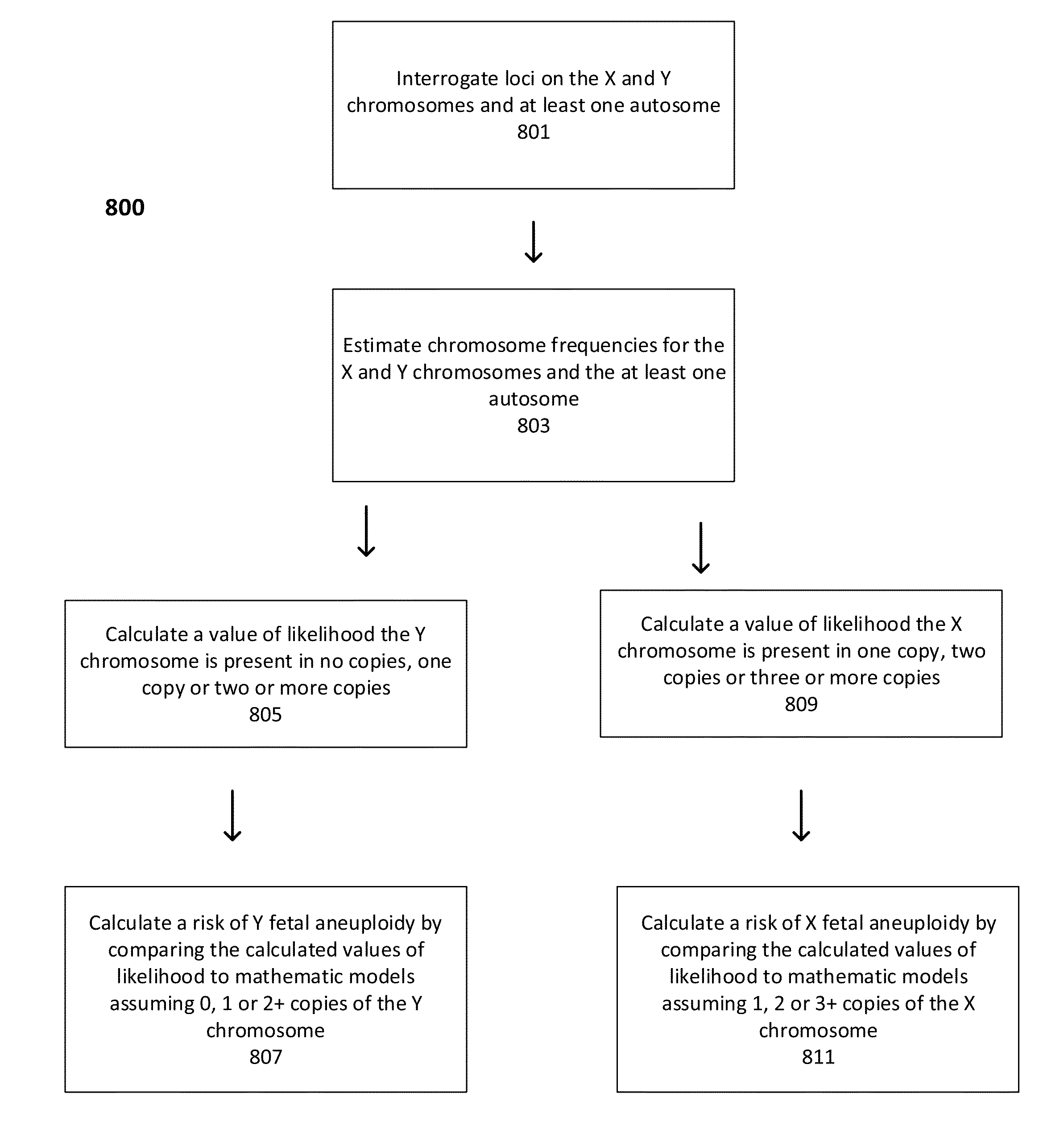Statistical analysis for non-invasive sex chromosome aneuploidy determination
- Summary
- Abstract
- Description
- Claims
- Application Information
AI Technical Summary
Benefits of technology
Problems solved by technology
Method used
Image
Examples
example 1
Preparation of DNA for Use in Tandem Ligation Procedures
[0159]Genomic DNA from subjects was obtained from Coriell Cell Repositories (Camden, N.J.) and fragmented by acoustic shearing (Covaris, Woburn, Mass.) to a mean fragment size of approximately 200 bp.
[0160]The DNA was biotinylated using standard procedures. Briefly, the Covaris fragmented DNA was end-repaired by generating the following reaction in a 1.5 ml microtube: 5 ug DNA, 12 μl 10×T4 ligase buffer (Enzymatics, Beverly Mass.), 50 U T4 polynucleotide kinase (Enzymatics, Beverly Mass.), and H20 to 120 μl. This was incubated at 37° C. for 30 minutes. The DNA was diluted using 10 mM Tris 1 mM EDTA pH 8.5 to desired final concentration of ˜0.5 ng / μl.
[0161]5 μl DNA was placed in each well of a 96-well plate, and the plate sealed with an adhesive plate sealer and spun for 10 seconds at 250×g. The plate was then incubated at 95° C. for 3 minutes, and cooled to 25° C., and spun again for 10 seconds at 250×g. A biotinylation master ...
example 2
Universal Amplification of Ligated Products
[0167]The polymerized and / or ligated nucleic acids were amplified using universal PCR primers complementary to the universal sequences present in the first and second fixed sequence oligos hybridized to the nucleic acid regions of interest. 25 μl of each of the reaction mixtures of Example 3 were used in each amplification reaction. A 50 μL universal PCR reaction consisting of 25 μL eluted ligation product plus 1×Pfusion buffer (Finnzymes, Finland), 1M Betaine, 400 nM each dNTP, 1 U Pfusion error-correcting thermostable DNA polymerase, and primer pairs with sample tags used to uniquely identify individual samples prior to pooling and sequencing. The PCR was carried out under stringent conditions using a BioRad Tetrad™ thermocycler.
[0168]10 μl of universal PCR product from each of the samples were pooled and the pooled PCR product was purified and quantified using Quant-iT™ PicoGreen, (Invitrogen, Carlsbad, Calif.). The purified PCR products...
example 3
Analysis of Polymorphic Loci to Assess Percent Fetal Contribution
[0169]To assess fetal nucleic acid proportion in the maternal samples, assays were designed against a set of SNP-containing loci on chromosomes 1 through 12, where two bridging oligos differing by one base were used to query each SNP (see, e.g., FIG. 3). SNPs were optimized for minor allele frequency in the HapMap 3 dataset. Duan, et al., Bioinformation, 3(3):139-41 (2008); Epub 2008 Nov. 9.
[0170]Oligonucleotides were synthesized by IDT (Coralville, Iowa) and pooled together to create a single multiplexed assay pool. PCR products were generated from each subject sample as previously described. Informative polymorphic loci were defined as loci where fetal alleles differed from maternal alleles. Because the assay exhibits allele specificities exceeding 99%, informative loci were readily identified when the fetal allele proportion of a locus was measured to be between 1 and 20%. A maximum likelihood was estimated using a ...
PUM
 Login to View More
Login to View More Abstract
Description
Claims
Application Information
 Login to View More
Login to View More - R&D
- Intellectual Property
- Life Sciences
- Materials
- Tech Scout
- Unparalleled Data Quality
- Higher Quality Content
- 60% Fewer Hallucinations
Browse by: Latest US Patents, China's latest patents, Technical Efficacy Thesaurus, Application Domain, Technology Topic, Popular Technical Reports.
© 2025 PatSnap. All rights reserved.Legal|Privacy policy|Modern Slavery Act Transparency Statement|Sitemap|About US| Contact US: help@patsnap.com



